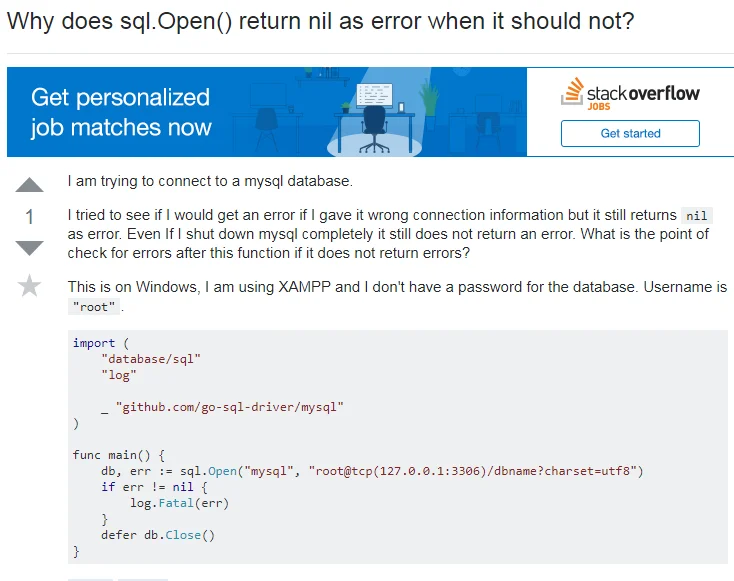
SQL.Open only creates the DB object, but dies not open any connections to the database. If you want to test your connections you have to execute a query to force opening a connection. The common way for this is to call Ping() on your DB object.
Quoting from the doc of sql.Open():
Open may just validate its arguments without creating a connection to the database. To verify that the data source name is valid, call Ping.
As stated, Open() may not open any physical connection to the database server, but it will validate its arguments. That being said if arguments are valid, it may return nil error even if the database server is not reachable, or even if the host denoted by dataSourceName does not exist.
To answer your other question:
What is the point of check for errors after this function if it does not return errors?
You have to check returned errors because it can return errors. For example if the specified driverName is invalid, a non-nil error will be returned (see below).
To test if the database server is reachable, use DB.Ping(). But you can only use this if the returned error is nil, else the returned DB might also be nil (and thus calling the Ping()method on it may result in run-time panic):
ifdb,err :=sql.Open("nonexistingdriver","somesource");err !=nil{fmt.Println("Error creating DB:",err)fmt.Println("To verify, db is:",db)}else{err =db.Ping()iferr !=nil{fmt.Println("db.Ping failed:",err)}}
Output (try it on the Go Playground):
Errorcreating DB:sql:unknown driver "nonexistingdriver"(forgotten import?)Toverify,db is:
sql.open("postgres", "postgres://postgres:postgres/xxxx")连接数据库出错的时候,也不会报错, 很奇怪,那这种错误是怎么处理的呢?
package main
import (
"database/sql"
"fmt"
_ "github.com/lib/pq"
"log"
)
var db *sql.DB
func main() {
defer func() {
fmt.Println(recover())
}()
var ss string
var err error
// var err error
if db != nil {
db.Close()
} else {
db, err = sql.Open("postgres", "postgres://postgres:postgres@127.0.0.1/xinyi?sslmode=disable")
if err != nil {
log.Println("Can't connect to postgresql database")
} else {
err = db.Ping()
if err != nil {
fmt.Println("db.Ping failed:", err)
}
}
err = db.QueryRow("select value from configs where key =$1", "line1_batch").Scan(&ss)
if err != nil {
log.Println("query error")
}
fmt.Println(ss)
}
}
-----------------------------------------------------------------------------------------------------
SQL Drivers
Go’s standard library was not built to include any specific database drivers. Here is a list of available third party SQL drivers http://golang.org/s/sqldrivers .
Setup
First we will need to import the packages that our program will use.
import (
“database/sql”
_ “github.com/lib/pq”
)
Here, we import the “database/sql” library which provides a generic interface for working with SQL databases. The second import, _”github.com/lib/pq”, is the actual postgresql driver. The underscore before the library means that we import pq without side effects. Basically, it means Go will only import the library for its initialization. For pq, the initialization registers pq as a driver for the SQL interface.
Open
Next we will need to open the database. It is important to note that calling “Open” does not open a connection to the database. The return from “Open” is a DB type and an error. The DB type represents a pool of connections which the sql package manages for you.
db, err := sql.Open(“postgres”,”user=Arnold dbname=TotalRecall sslmode=disable”)
“Open” returns an error which validates the arguments of a database open
if err != nil {
log.Fatal(“Error: The data source arguments are not valid”)
}
Ping
Since the error returned from “Open” does not check if the datasource is valid calling Ping on the database is required
err = db.Ping()
if err != nil {
log.Fatal(“Error: Could not establish a connection with the database”)
}
Prepare
Once the DB has been set up, we can start safely preparing query statements. “Prepare” does not execute the statement.
queryStmt, err := db.Prepare(“SELECT name FROM users WHERE id=$1”)
if err != nil {
log.Fatal(err)
}
QueryRow
We can now “QueryRow” off of the prepared statement and store the returned row’s first column into the “name string”. “QueryRow” only queries for one row.
var name string
err = queryStmt.QueryRow(15).Scan(&name)
In addition, a common error check is for “No Rows”. Some programs handle “No Rows” differently from other scanning errors. Errors like this are specific to the library, not Go in general.
if err == sql.ErrNoRows {
log.Fatal(“No Results Found”)
}
if err != nil {
log.Fatal(err)
}
You can also skip explicitly preparing your Query statements.
var lastName string
err = db.QueryRow(“SELECT last_name FROM users WHERE id=$1”, 15).Scan(&lastName)
if err == sql.ErrNoRows {
log.Fatal(“No Results Found”)
}
if err != nil {
log.Fatal(err)
}
Query
We can also handle a Query that returns multiple rows and stores the result into a “names” slice. In the code below you will see “rows.Next”, which moves the cursor to the next result row. If there is no next row or error preparing the next row, a false will be returned.
var names []string
rows, err := queryStmt.Query(15)
defer rows.Close()
for rows.Next() {
var name string
if err := rows.Scan(&name); err != nil {
log.Fatal(err)
}
names = append(names, name)
}
This next check is for any errors encountered during the iteration.
err = rows.Err()
if err != nil {
log.Fatal(err)
}
Conclusion
Golang’s standard sql package is extremely simple, yet powerful. This post covers the basics of the sql package. If you would like to learn more, visit the official docs at: http://golang.org/pkg/database/sql. Feel free to leave any comments or questions.
有疑问加站长微信联系(非本文作者)

